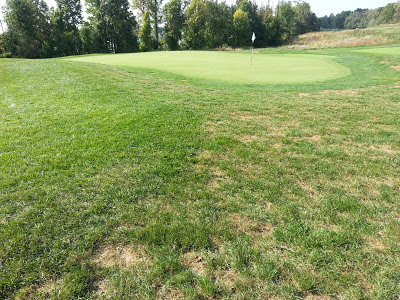After another FUN Mid-Atlantic summer, our superintendents have changed gears from the hectic days of high-stress turfgrass management to the more predictable time of year when grass growth has slowed to a minimum, and our focus shifts to leaf removal and beginning to work on projects that will enable us to continue to improve our facilities.
August and September saw us begin in earnest cultural practices including aeration and seeding of greens, tees, fairways, and rough, and final rounds of weed control, topdressing, and vertical mowing.
 |
| Best large-area aerator in the industry providing some turf relief! |
 |
| 100% tall fescue on the left (sod area); mixed stand on the right where gray leaf spot negatively impacted the rough. |
Hurricane (or Superstorm) Sandy brought with her extreme devastation to so many areas locally and especially, of course, New Jersey and New York. MCG's golf courses were VERY fortunately spared from much of this damage. We had a few trees come down and some damage to things like roadside netting. Bunkers were also flooded with about 8 inches of rainfall, but fortunately, the main impact from Sandy affecting playability of the courses was copious amounts of leaves that fell. With the golf courses totally saturated, large equipment could not be used for a couple of days to remove leaves, so maintenance staffs did a lot of hand work getting the courses ready for play again.
 |
| Anyone have a leaf rake? |
Mowing grass has slowed to about once a week at this point, but our goal is still to keep great greens for you, so we continue to roll the greens to maintain surface smoothness and green speed. We are also running into numerous frost delays, but be assured we are doing everything we can in order to get you on the course ASAP! More info on frost here, or here (highly detailed article).
Stay tuned for additional posts this week about some of the projects we are starting to work on... greens drainage, tee construction, bunker rebuilds, irrigation upgrades, etc. Mother nature has slowed down, but MCG teams will be hard at work all winter!!!

No comments:
Post a Comment